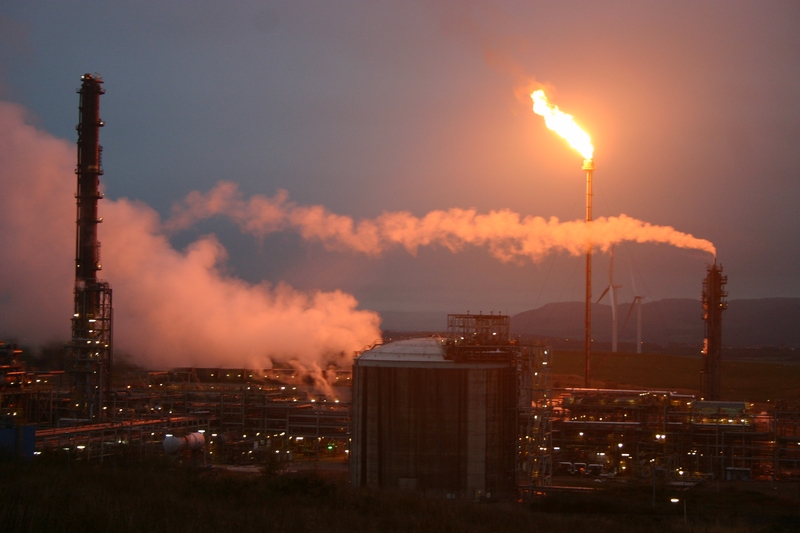Polluting flares from oil and gas multinationals in Scotland, ExxonMobil and Shell, have risen to a record high, according to a new analysis by the Scottish Environment Protection Agency (Sepa).
The weight of waste gases burnt off by both companies at the Mossmorran petrochemical complex near Cowdenbeath in Fife reached 38,747 tonnes in 2016 – the highest in the last ten years and nearly six times higher than in 2014.
The pollution disrupts the climate, and has been blamed by local residents for causing stress and breathing difficulties. Politicians and campaigners are calling on authorities to crack down, and check whether the ageing facilities at the site are deteriorating.
The companies, however, stress that flaring is a normal part of safe operation and increases during plant maintenance. It poses no significant risk to health, they say.
ExxonMobil runs an ethylene production plant and Shell a gas extraction plant at Mossmorran. In 2016 the complex was Scotland’s third biggest climate polluter.
ExxonMobil’s plant is currently under investigation by Sepa following two major flaring incidents over 17 days in June and October this year. The company could face legal enforcement action or prosecution.
Oil giants under fire after breakdowns trigger nine days of flaring
The new analysis by Sepa, released online, shows that since 2008 more than 187,000 tonnes of gas have been flared from Mossmorran in 1,423 “events”. There were also 22 unplanned “process upsets” at the ExxonMobil plant and at least six at the Shell plant that resulted in flaring.
The bulk of the flared gases – 165,861 tonnes – came from ExxonMobil, while the total number of flaring events rose from 39 in 2008 to 181 in 2016. In the same period the total amount of gas flared annually rose 38 per cent by over 10,000 tonnes.
The local Mossmorran Action Group pointed out that reports of flaring were made voluntarily by the companies and did not record how long they lasted. “Often the plant burns off gas for several days and nights, with noise, vibration and light pollution invading people’s homes and airborne pollution visible as dirty deposits on outdoor surfaces,” said the group’s chairperson, James Glen.
“During recent bouts of extended flaring we received reports of sleep disturbance, breathing difficulties and heightened levels of stress and anxiety among children and adults who live nearby.”
Glen blamed the recent increase in flaring on unplanned failures and breakdowns as equipment aged. “It’s obviously cheaper for the operators to inflict pollution and risk on neighbouring communities than invest in modernising and upgrading the facilities,” he argued.
Dr Richard Dixon, director of Friends of the Earth Scotland, accused ExxonMobil and Shell of having a “terrible track record” on flaring that was getting worse. “Current investigations need to lead to serious penalties if the site’s operators are to take this seriously enough to make sure there is no repeat,” he said.
“The operators’ problems have left people angry and wanting guarantees that these plants are being run properly.”
The Green MSP for Mid Scotland and Fife, Mark Ruskell, contended that the two companies had serious questions to answer. “Local people repeatedly report to me the disturbance in their lives caused by noise, vibrations and light pollution during flaring incidents,” he said.
“There are also major concerns about the transparency of operations at the site and the relationship between the plant operators and the local community.”
The Labour MSP for Mid Scotland and Fife, Alex Rowley, is calling on the Scottish Government to conduct an independent review of Mossmorran. “The amount of gas being flared by these companies is quite staggering and the increase in incidents of flaring is very worrying for the people who live in the communities surrounding the plant,” he said.
Sepa stressed that its comments had to be limited to avoid prejudicing potential enforcement action. Its investigation on ExxonMobil was “in advanced stages”, said area manager, Rob Morris.
He added: “Sepa will now move to consider its enforcement action against the company, and will do so in accordance with our enforcement policy, with options ranging from enforcement notices requiring defined actions, restrictions to the site’s permit to operate, or the submission of a report to the Procurator Fiscal for their consideration of prosecution.”
Morris promised that Sepa would openly notify community stakeholders about its enforcement decisions “as soon as this is possible”. The agency has started sharing regular updates about flaring incidents.
ExxonMobil insisted that flaring was safe, with independent monitoring saying that there was “no significant risk to the health of members of the local community.” Flaring was higher in 2016 due to planned maintenance but a Fife Council review concluded there were “no obvious trends” towards more or less flaring over time.
“The Fife Ethylene Plant is one of the most modern and efficient plants of its type in Europe, and we conduct continuous maintenance to ensure safe and environmentally responsible operations of the plant,” said a company spokesman.
“Every few years we conduct more intensive maintenance utilising the latest technologies. This investment in the plant’s future operations carries the occasional need for longer than normal periods of flaring in order to enable the planned maintenance work to be completed safely.”
He added: “We regret any concern that flaring may cause. We minimise flaring where possible, and make every effort to restore operations as quickly as we can.”
Shell said it shared a full log of flaring events with Sepa annually, recently including more detail and smaller events. “The higher volume in 2016 is due to major planned maintenance activity across the Mossmorran complex,” said a company spokesperson.
“Shell annual flaring volumes are less than 0.1 per cent of throughput at the plant, which provides oil and gas to meet industry and domestic power needs, and premium fuels and feedstock to manufacture a wide range of household products.”
Photo credit: AlexNoel66 | CC | Wikipedia














